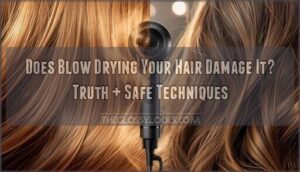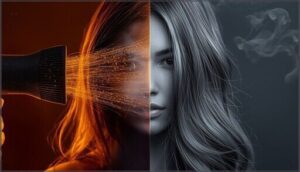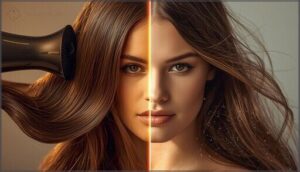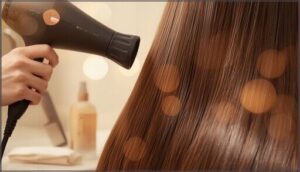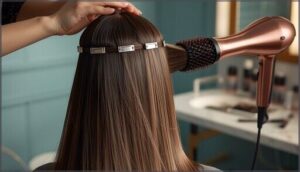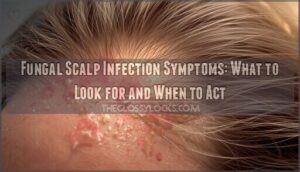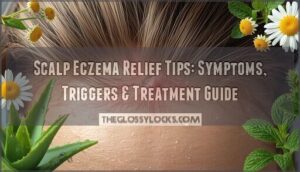This site is supported by our readers. We may earn a commission, at no cost to you, if you purchase through links.
You’ve probably stood in front of the mirror, blow dryer in hand, wondering if you’re slowly frying your hair with every pass. The short answer? Yes, blow drying can damage your hair—but so can skipping it entirely. Heat above 150°C starts lifting your hair’s protective cuticle layer, accelerating moisture loss and weakening the protein structure that keeps strands strong.
But here’s the twist most people miss: letting your hair air-dry isn’t the damage-free alternative you think it is. Prolonged wetness causes something called hygral fatigue, where your hair swells and contracts repeatedly, leading to breakage and frizz.
The real question isn’t whether to blow dry, but how to do it right so you can style confidently without turning your hair into straw.
Table Of Contents
Key Takeaways
- Blow drying damages hair above 150°C by lifting cuticles and weakening keratin, but prolonged air-drying causes hygral fatigue that leads to breakage and frizz—both methods harm your hair when done wrong.
- Research shows proper blow-drying at 15 cm with constant motion actually causes less internal damage than hours of air-drying, flipping the myth that heat is always worse for your strands.
- Heat damage shows up as dryness, dullness, split ends, constant breakage, unmanageable frizz, and rough texture that snaps easily—signs your technique or temperature needs fixing fast.
- Safe blow-drying means keeping your dryer 15 cm away, using medium heat with continuous motion, always applying heat protectant, and limiting sessions to 2-3 times weekly so your hair can recover between styling.
Does Blow Drying Hair Cause Damage?
Yes, blow drying can damage your hair, but the real story is more nuanced than you might think. The key is understanding what actually happens when heat hits your hair strands, and separating the myths from the facts.
Let’s break down how heat affects your hair structure, what signs to watch for, and what’s actually true about blow drying damage.
How Heat Affects Hair Structure
Heat changes your hair at the molecular level. When you blow-dry above 150°C, you’re disrupting hydrogen bonds in keratin and causing cuticle lifting. That thermal stress accelerates moisture loss from the cortex, making strands brittle. At 200°C, keratin literally starts to denature—your protein structure weakens permanently.
A heat protectant creates a barrier against thermal damage, but understanding hair structure helps you protect it better. To minimize damage, you must use heat styling tools carefully and follow proper hair care techniques.
Common Signs of Heat Damage
You’ll spot the signs fast. Dryness causes dullness—your hair won’t shine even after washing. Split ends multiply, breakage happens constantly, and you’ll notice frizz that won’t quit no matter how much conditioner you use.
The right leave-in products for hydration can restore moisture balance without tipping into overload.
If your strands feel rough, snap easily when you stretch them, or won’t hold a style anymore, that’s heat damage showing up. Higher hair porosity means moisture escapes quickly, leaving you battling constant dryness.
If you’re unsure whether damage or natural texture is causing the roughness, understanding your wavy hair texture can help you spot the real issue.
Understanding the effects of heat damage signs is essential for effective hair care.
Myths Vs. Facts About Blow Drying
Once you know what damage looks like, you can bust the myths. Here’s what’s actually true about blow drying techniques and thermal damage:
- Blow drying doesn’t always destroy hair—moderate heat at 15 cm causes less damage than air-drying for hours
- Heat protectants aren’t just marketing—they form a barrier that reduces protein loss and lowers surface temperature
- Air-drying isn’t automatically safer—prolonged wetness weakens hair fiber structure at the cell membrane complex
- Frizz isn’t inevitable—proper blow dryer settings and distance smooth cuticles better than uncontrolled drying
- Device claims matter less than technique—temperature, motion, and hair damage prevention habits trump fancy features
It’s all about how you use the dryer, not whether you use it.
Factors That Increase Blow Drying Damage
Not all blow drying sessions are created equal. Some habits can turn a quick styling routine into a recipe for serious damage, while others keep your hair looking healthy.
Let’s break down the main culprits that make blow drying riskier than it needs to be.
Choosing a quality hair dryer designed for your hair type is the first step toward minimizing heat damage.
Heat Settings and Exposure Time
Turning up the heat might dry your hair faster, but you’re playing with fire—literally. Studies show fiber temperatures above 95°C cause severe cuticle cracking, while keeping things around 47°C produces only minor damage. The trick? Use low to medium heat settings and keep moving. Here’s what actually happens at different temperatures:
Pairing smart heat habits with stronger, healthier hair follicles gives you the best defense against long-term damage.
| Distance | Fiber Temp | Damage Level |
|---|---|---|
| 15 cm | ~47°C | Minimal cracks |
| 10 cm | ~61°C | Moderate lifting |
| 5 cm | ~95°C | Severe breakage |
Your blow dryer’s high setting can push surface temps past safe thermal limits, especially when you hold it close or linger too long on one section. Each pass adds up—after 30 cycles, researchers found accumulated surface damage even at lower settings. That’s why heat damage prevention starts with temperature control and constant motion, not just slapping on heat protectant and hoping for the best.
Think of exposure time like leaving cookies in the oven. A few seconds too long won’t ruin them, but repeat it daily and you’ll end up with burnt edges every time. Hair works the same way—cumulative thermal stress from frequent high-heat styling breaks down proteins and strips protective oils. Consumer dryers usually run 60–80°C at the nozzle, which sounds safe until you realize holding it still creates hot spots that spike temps dangerously high.
The sweet spot for blow drying balances speed with safety. Keep your dryer moving continuously, stick to medium heat, and aim for 10–15 minutes max. Studies confirm this approach causes less structural damage than air-drying for hours, which swells and weakens internal bonds. Smart heat styling means respecting your hair’s thermal limits while avoiding prolonged wetness—both extremes cause problems, but moderate blow-drying with proper technique gives you control over exposure risks without sacrificing your hair’s integrity.
For a polished finish, follow professional hair styling techniques that break your drying routine into sections, preventing overexposure to any single area.
Hair Type and Porosity Considerations
Your hair texture, porosity levels, and curl patterns all respond differently to heat. Fine hair shows damage faster than coarse strands, while high-porosity hair loses moisture quicker during blow drying. Curly hair types need lower temperatures than straight hair to prevent breakage.
Dense hair requires sectioning to avoid prolonged heat exposure, which throws off moisture balance and compromises hair health even with heat protectant applied.
Frequency of Blow Drying
Generally, limiting blow drying to two or three times per week gives your hair recovery time between heat sessions. Daily blow drying strips protective oils faster and accelerates breakage, even with heat protectant.
High-porosity or color-treated hair needs fewer sessions—think of it as damage prevention tips that actually work.
Safe styling habits mean alternating heat-free days so your strands can rebuild their natural moisture barrier and maintain hair health.
Comparing Blow Drying and Air-Drying
You might assume air-drying is always the gentler choice, but the truth isn’t that simple. Both methods affect your hair differently, and understanding those differences helps you make smarter decisions.
Let’s break down what each approach does to your hair, what research actually shows, and how to figure out which works best for you.
Pros and Cons of Blow Drying
So here’s the real deal with blow drying: yes, your hair dryer can cause hair damage if you crank up the heat without protection. It’s all about damage control through smart technique, not ditching heat protection altogether.
But when you use heat protectant and follow proper blow dry tips, you get faster styling options, less frizz, and better control over your hair texture.
Potential Damage From Air-Drying
Surprise: letting your hair air dry isn’t always the gentle option you think it is. Prolonged dampness triggers hygral fatigue, where your strands swell and contract repeatedly, causing hair breakage and frizz over time.
Here’s what actually happens during air drying:
- Weakened structure – Wet hair stretches beyond its limits, making it vulnerable to snaps and splits
- Cuticle lifting – Extended moisture exposure causes hair weathering and surface damage
- Increased porosity – Your hair absorbs more water than it should, leading to chronic dryness
- Scalp issues – Dampness disrupts microbiome balance, encouraging fungal growth
- Tangling nightmares – Damp strands knot easier, requiring forceful detangling that causes hair damage
High-porosity and curly hair types face the worst effects. Your scalp health suffers too when moisture lingers for hours, creating the perfect environment for dandruff and irritation. Proper hair care means controlling how long your strands stay wet, not just avoiding heat.
Scientific Studies on Hair Drying Methods
One pivotal study flipped everything we thought we knew: researchers at Yonsei University used electron microscopy to compare heat versus air-drying damage on actual hair fiber analysis. Their thermal damage findings? Blow drying at 15 cm with constant motion caused less internal structural harm than prolonged air-drying.
A Yonsei University study found that proper blow-drying damages hair less than prolonged air-drying
The drying method comparison revealed that cuticle protection matters more than avoiding heat entirely—moisture retention during extended wetness weakened fibers from within, contradicting popular hair science myths about heat protection.
How to Minimize Blow Drying Damage
You don’t have to choose between speed and healthy hair. A few simple adjustments to your routine can drastically cut down the damage from blow drying, no matter your hair type.
Let’s walk through the essential steps that protect your strands from root to tip.
Proper Towel-Drying Techniques
Your towel choice matters more than you think. Microfiber towels cut friction by nearly half compared to cotton terry, protecting those delicate cuticles while you prep for blow drying.
Forget the rough rubbing—gentle blotting and squeezing removes water without stretching vulnerable wet strands.
This simple hair protection step reduces mechanical damage and shortens your overall heat exposure, giving you healthier results every time.
Safe Distance and Motion of Dryer
Keep your blow dryer about six inches from your hair—around 15 cm—to prevent concentrated heat damage. Constant motion is your safety net here; sweep the dryer continuously rather than holding it in one spot. Point the nozzle downward along your hair shaft for better heat distribution and smoother cuticles. These distance control and motion techniques transform heat styling from risky to protective.
Recommended Tools and Brushes
Beyond distance and motion, your blow drying tools matter just as much. Vented brushes speed drying by letting air circulate through, cutting heat exposure time. Round brushes add volume while smoothing, and paddle combs work wonders for detangling thick hair. Choose nylon bristles over boar for heat tolerance.
Always pair your hair dryer with heat protectants—they’re non-negotiable styling tools for damage control.
Best Blow Drying Practices for Healthy Hair
Now that you know how to protect your hair, it’s time to put those strategies into action with the right techniques.
The way you handle your dryer matters just as much as the products you use, and your approach should match your specific hair type.
Let’s break down the best practices that’ll keep your hair healthy while giving you the style you want.
Techniques for Different Hair Types
Your hair type sets the rules for how you blow dry without causing damage. Straight styling works best when you point the nozzle down the shaft to smooth cuticles, while curly hair care demands a diffuser on low heat to preserve your natural pattern.
For fine hair methods, stick to 300–350°F and lift at the roots. Thick hair management means working in small sections—it cuts down your heat exposure time dramatically.
Sectioning and Styling Tips
Once you’ve matched your technique to your hair type, smart sectioning makes all the difference. Divide your hair into at least four parts—top, sides, and back—clipping each away.
Start at the nape and work upward in subsections no wider than your brush. These blowout techniques give you control, minimize heat damage, and deliver salon-worthy volume methods without extra passes.
Frequently Asked Questions (FAQs)
How does blow-drying impact the health of the hair cuticles?
High heat lifts those protective overlapping scales on your hair shaft, causing roughness and dullness. Repeated thermal stress accelerates cuticle damage, but smart blow drying with heat protectants keeps cuticles smooth and healthy.
What type of heat protectant is recommended for blow-drying?
Look for silicone sprays, polymer films, or protein protectants that shield up to 450°F.
Oil emollients and thermal serums work well too—choose lightweight mists for fine hair, richer creams for thick strands.
Should you blow dry hair when its wet or damp?
You should always blow dry damp hair, not sopping wet. Start when your hair’s about 70 to 80 percent dry—this cuts heat exposure time and protects your cuticles from unnecessary thermal damage.
Can you blow dry hair every day safely?
You can blow dry hair every day safely if you stick to lower heat settings, use heat protectants, and keep the dryer moving at a distance—your hair won’t thank you for shortcuts.
Does cold air setting prevent all heat damage?
No, cold air can’t stop all damage. It removes thermal stress but won’t prevent mechanical friction from brushing or dryness from extended airflow.
You still need heat protectants and proper technique for full protection.
Conclusion
Your blow dryer doesn’t have to be your hair’s worst enemy. Does blow drying your hair damage it? Only when you ignore the basics—distance, heat settings, and prep work. Master those three, and you’re not choosing between damage and styling; you’re taking control of both.
The difference between fried ends and salon-worthy shine isn’t luck or expensive products. It’s technique, applied consistently. Your hair can handle the heat when you handle the dryer right.
- https://www.elle.com.au/beauty/beauty-news/is-air-drying-hair-bad-28177/
- https://thebraidstop.com/debunking-the-myth-about-blow-drying-4c-hair-and-heat-damage/
- https://blog.functionofbeauty.com/lightreads/is-blow-drying-your-hair-bad/
- https://www.livingproof.com/blogs/hair-101/is-blow-drying-hair-bad
- https://www.reddit.com/r/HaircareScience/comments/1og46sk/is_there_any_evidence_that_drying_with_high_heat/

